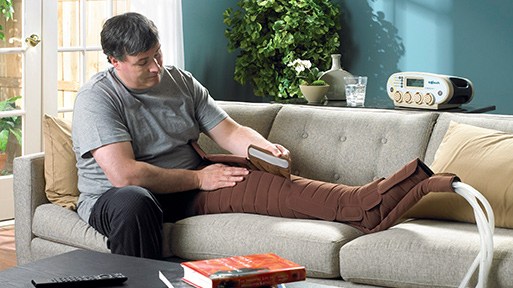Lymphedema Therapy
Treatment Approaches
Treatment varies depending on the severity of edema and the degree of fibrosis.
Most people with lymphedema follow a daily regimen of treatment. The most common treatments are a combination of manual compression lymphatic massage, compression garments or bandaging.
Complex decongestive physiotherapy is an empiric system of lymphatic massage, skin care and compressive garments.
Although a combination treatment program may be ideal, any of the treatments can be done individually.

Complete Decongestive Therapy (CDT)
CDT is a primary tool in lymphedema management. It consists of manual manipulation of the lymphatic ducts,[1] short-stretch compression bandaging, therapeutic exercise and skin care. The technique was pioneered by Emil Vodder in the 1930s for the treatment of chronic sinusitis and other immune disorders.
Initially, CDT involves frequent visits to a therapist. Once the lymphedema is reduced, increased patient participation is required for ongoing care, along with the use of elastic compression garments and nonelastic directional flow foam garments.
Bandaging
Compression bandaging, also called wrapping, is the application of layers of padding and short-stretch bandages to the involved areas.
Short-stretch bandages are preferred over long-stretch bandages (such as those normally used to treat sprains), as the long-stretch bandages cannot produce the proper therapeutic tension necessary to safely reduce lymphedema and may in fact end up producing a tourniquet effect.
During activity, whether exercise or daily activities, the short-stretch bandages enhance the pumping action of the lymph vessels by providing increased resistance. This encourages lymphatic flow and helps to soften fluid-swollen areas.
A 2002 study showed patients receiving the combined modalities of manual lymphatic drainage (MLD) with complete decongestive therapy (CDT) and pneumatic pumping had a greater overall reduction in limb volume than patients receiving only MLD/CDT.2

Intermittent Pneumatic Compression Therapy (IPC)
Intermittent pneumatic compression therapy (IPC) utilizes a multi-chambered pneumatic sleeve with overlapping cells to promote movement of lymph fluid.
Pump therapy should be used in addition to other treatments such as compression bandaging and manual lymph drainage. In some cases, pump therapy helps soften fibrotic tissue and therefore potentially enable more efficient lymphatic drainage.
However, reports link pump therapy to increased incidence of edema proximal to the affected limb, such as genital edema arising after pump therapy in the lower limb.3 IPC should be used in combination with complete decongestive therapy.4 (It is highly recommended that a core-trunk piece be utilized with the Lymphedema pump to avoid this problem).

Compression garments should be worn during exercise (with the possible exception of swimming in some patients).8
Patients who have or risk lymphedema should consult their physician or certified lymphedema therapist before beginning an exercise regimen.
Resistance training is not recommended in the immediate post-operative period in patients who have undergone axillary lymph node dissection for breast cancer.
Few studies examine the effects of exercise in primary lymphedema or in secondary lymphedema that is not related to breast cancer treatment.
Footnotes:
1. http://www.lymphnet.org/pdfDocs/nlntreatment.pdf
2. Szuba A, Achalu R, Rockson SG (2002). "Decongestive lymphatic therapy for patients with breast carcinoma-associated lymphedema". Cancer. 95 (11): 2260–7. doi:10.1002/cncr.10976. PMID 12436430.
3. Boris M, Weindorf S, Lasinski BB (Mar 1998). "The risk of genital edema after external pump compression for lower limb lymphedema". Lymphology. 31 (1): 15–20. PMID 9561507.
4. Markes M, Brockow T, Resch KL (2006). "Exercise for women receiving adjuvant therapy for breast cancer". The Cochrane database of systematic reviews (4): CD005001. doi:10.1002/14651858.CD005001.pub2. PMID 17054230.
5. McKenzie DC, Kalda AL (2003). "Effect of upper extremity exercise on secondary lymphedema in breast cancer patients: A pilot study". Journal of Clinical Oncology. 21 (3): 463–6. doi:10.1200/jco.2003.04.069. PMID 12560436.
6. Ahmed RL, Thomas W, Yee D, Schmitz KH (2006). "Randomized controlled trial of weight training and lymphedema in breast cancer survivors". Journal of Clinical Oncology. 24 (18): 2765–72. doi:10.1200/JCO.2005.03.6749. PMID 16702582.
7. Schmitz KH, Ahmed RL, Troxel A, Cheville A, Smith R, Lewis-Grant L, Bryan CJ, Williams-Smith CT, Greene QP (2009). "Weight lifting in women with breast-cancer-related lymphedema". New England Journal of Medicine. 361 (7): 664–73. doi:10.1056/NEJMoa0810118. PMID 19675330.
8. "Position Paper: Exercise | National Lymphedema Network". Lymphnet.org. Retrieved 2014-05-16.

Manual manipulation of the lymphatic ducts (manual lymphatic drainage or MLD) consists of gentle, rhythmic massage to stimulate lymph flow and its return to the blood circulation system.
The treatment is gentle. A typical session involves drainage of the neck, trunk and involved extremity (in that order), lasting approximately 40 to 60 minutes. CDT is generally effective on nonfibrotic lymphedema and less effective on more fibrotic legs, although it helps break up fibrotic tissue.
Compression Therapies
Compression Garments
Elastic compression garments are worn on the affected limb following complete decongestive therapy to maintain edema reduction. Inelastic garments provide containment and reduction.
Exercise
Most studies investigating the effects exercise have in patients with lymphedema or at risk of developing lymphedema examined patients with breast-cancer-related lymphedema. In these studies, resistance training did not increase swelling in patients with pre-existing lymphedema and decreases edema in some patients, in addition to other potential beneficial effects on cardiovascular health.4,5,6,7
Moreover, resistance training and other forms of exercise were not associated with an increased risk of developing lymphedema in patients who previously received breast cancer-related treatment.




